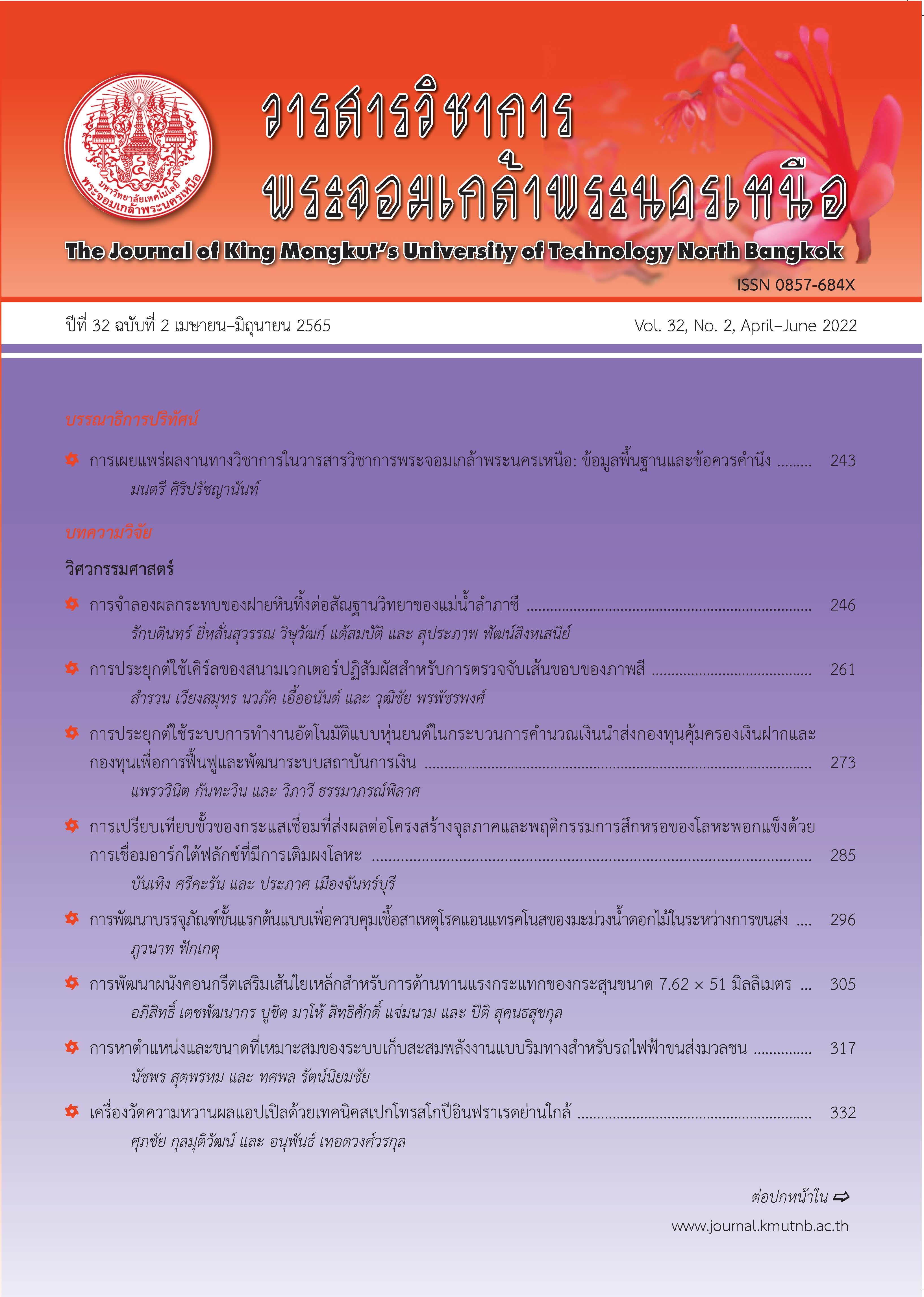อิทธิพลขององศาการฉีดน้ำมันเชื้อเพลิงต่อสมรรถนะ การเผาไหม้ และมลพิษของเครื่องยนต์ดีเซลโดยใช้เชื้อเพลิงดีเซลผสมน้ำมันไพโรไลซิสจากพลาสติก
Main Article Content
บทคัดย่อ
งานวิจัยนี้เพื่อศึกษาอิทธิพลขององศาการฉีดของน้ำมันเชื้อเพลิงที่เหมาะสมสำหรับเครื่องยนต์ดีเซลที่ใช้น้ำมันไพโรไลซิสจากพลาสติกเป็นเชื้อเพลิง น้ำมันไพโรไลซิสถูกกลั่นในกรบวนการโดยไม่ผ่านการปรับแต่งคุณภาพ อัตราส่วนน้ำมันดีเซล (B7) ผสมกับน้ำมันไพโรไลซิสที่ 50:50, 60:40, 70:30, 80:20 และ 90:10 โดยนำมาทดสอบความเร็วรอบ 1,500 รอบต่อนาที และภาระงานของเครื่องยนต์ 50% คงที่ โดยทำการปรับเปลี่ยนองศาการฉีดน้ำมันเชื้อเพลิงที่ -15.5, -16.5 และ -17.5 องศาเพลาข้อเหวี่ยง (Crank Angle Degree, CAD) เพื่อหาสภาวะที่เหมาะสมของเครื่องยนต์ โดยงานวิจัยพบว่า เมื่ออัตราส่วนผสมน้ำมันไพโรไลซิสในน้ำมันเชื้อเพลิงดีเซลที่สูงขึ้นสำหรับเครื่องยนต์ที่ไม่ได้ปรับแต่ง ส่งผลให้เกิดความล่าช้าในการฉีดของน้ำมันผสม ดังนั้นการปรับตั้งการฉีดน้ำมันเชื้อเพลิงที่ -16.5 องศาเพลาข้อเหวี่ยง (CAD) ช่วยปรับปรุงการเผาไหม้ของเชื้อเพลิงผสมน้ำมันไพโรไลซิสให้ดีขึ้น โดยที่อัตราส่วนผสมของน้ำมันไพโรไลซิสผสมดีเซลที่ 60:40 เป็นอัตราส่วนเหมาะสมที่สุด โดยพิจาณาจากประสิทธิภาพการเผาไหม้สูงขึ้น และมีอัตราความสิ้นเปลืองน้ำมันเชื้อเพลิงจำเพาะที่ดีที่สุด โดยการปลดปล่อยมลพิษที่ลดลง ดังนั้นการปรับแต่งองศาการฉีดน้ำมันเชื้อเพลิงสำหรับน้ำมันไพโรไลซิสที่มีอัตราส่วนผสมจึงมีความจำเป็นเพื่อให้เครื่องยนต์มีประสิทธิภาพสูงสุด
Article Details

อนุญาตภายใต้เงื่อนไข Creative Commons Attribution-NonCommercial-NoDerivatives 4.0 International License.
บทความที่ลงตีพิมพ์เป็นข้อคิดเห็นของผู้เขียนเท่านั้น
ผู้เขียนจะต้องเป็นผู้รับผิดชอบต่อผลทางกฎหมายใดๆ ที่อาจเกิดขึ้นจากบทความนั้น
เอกสารอ้างอิง
Pollution Control Department. (2018). Thailand State of Pollution Report 2018. Ministry of Natural Resources and Environment. Bangkok, Thailand [Online]. (in Thai). Available: http://www.pcd. go.th/file/AW-Pollution-Report2018.pdf
S. D. A. Sharuddin, F. Abnisa, W. M. W. Daud, and M. K. Aroua, “A review on pyrolysis of plastic wastes” Energy Conversion and Management, vol. 115, pp. 308–326, 2016.
C. Wongkhorsub and N.Chindaprasert, “A comparison of the use of pyrolysis oils in diesel engine,” Energy and Power Engineering, 2013, 5, pp. 350–355.
I. Kalargaris, G. Tian, and S. Gu, “Combustion performance and emission analysis of a DI diesel engine using plastic pyrolysis oil,” Fuel Processing Technology, vol. 157, pp. 108–115, 2017.
Energy Policy and Planning office (EPPO). Waste plastic pyrolysis oil support policy guideline. Ministry of Energy. Bangkok, Thailand [Online]. (in Thai). Available: http://www. eppo.go.th/ epposite/index.php/th/petroleum/biofuel/ oil-garbage
M. Mania and G. Nagarajan, “Influence of injection timing on performance, emission and combustion characteristics of a DI diesel engine running on waste plastic oil,” Energy, vol. 34, no. 10, pp. 1617–1623, 2009.
R. Miandad, M. A. Barakat, A. S. Aburiazaiza, M. Rehan, I. M. I., and A. S. Nizami, “Effect of plastic waste types on pyrolysis liquid oil” International Biodeterioration & Biodegradation, vol. 119, pp. 239–252, 2017.
J. Devaraj, Y. Robinson, and P.Ganapathi, “Experimental investigation of performance, emission and combustion characteristics of waste plastic pyrolysis oil blended with diethyl ether used as fuel for diesel engine,” Energy, vol. 85, pp. 304–309, 2015.
YANMAR. (2005). LV series OPERATION MANUAL. Yanmar Co., Ltd. Japan [online]. Available:https://www.nuvair.com/manuals/ Yanmar-LV-100-Use-Manual.pdf
N. Sirisawat, P. Thaiyasuit, and K. Pianthong, “Combustion characteristic and performance of small CI engine using palm biodiesel-ethanol blend as fuels” UBU Engineering Journal, vol. 8, no. 1, 2015 (in Thai).
S. Maithomklang, T. Henkeaw, S. Tessungnern, E. Sukji, and A. Maneedang “Engine performance and emissions of microemulsion-based from waste plastic oil and hydrous ethanol,” in Proceedings 14th Conference On Energy Network of Thailand (E-NETT), 2018, pp. 762– 769 (in Thai).
A. S. Ramadhas, C. Muraleedharan, and S. Jayaraj, “Performance and emission evaluation of a diesel engine fueled with methyl esters of rubber seed oil,” Renewable Energy, vol. 30, no. 12, pp. 1789–1800, 2005.
S. Peanprasit, N. Chindaprasert, C. Wongkhorsub, P. Sankasem, and P. Tinprabath, “The comparison of the alternative fuel properties at low temperatures,” in Proceedings the 8th RMUTP ICON SCI Conference, 2017, pp. 154 (in Thai).

